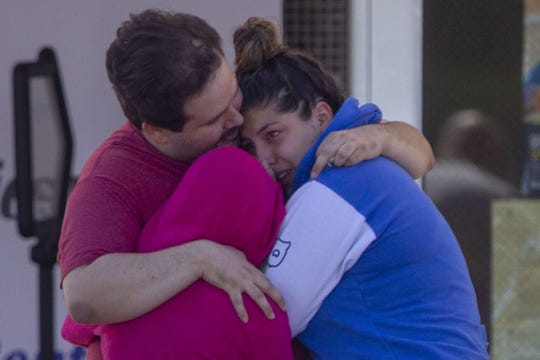More than two dozen people are dead, one as young as 2, in two separate shootings within 24 hours.
Parents will be asked to explain the unfathomable to their children. In Dayton, Ohio, nine people, including the sister of the shooting suspect, died Sunday in an entertainment district. The suspect was fatally shot by police. In El Paso, Texas, a gunman is in police custody after his possible hate crime rampage left 20 dead at a busy Walmart.
What do you say? How do you begin?
The conversations aren’t easy, even though parents likely have been having them more frequently, with 251 mass shootings in 2019.
Loved ones comfort each other outside of the reunification center at MacArthur School Elementary-Intermediate School on Aug. 4, 2019, in El Paso, Texas. (Photo: Madeleine Cook/Arizona Republic)
Whoa! Twitter thought he missed the mark: Twitter slams Neil deGrasse Tyson for ‘tasteless’ tweet about mass shootings
Your primary job as a parent, experts say, even amid all the photos and video of pain and suffering, is to point out the power of humanity.
“We can’t become numb to this or any other tragedy,” Richard Weissbourd, a child and family psychologist with Harvard’s School of Education and author of “The Parents We Mean to Be” told USA TODAY.
Teens can be especially vulnerable to this, given a run-on buffet of exposure to news images and photos through social media.
Remember the 4 S’s
No script exists for how to talk to children. But Dr. Robbie Adler-Tapia, an Arizona-based licensed psychologist, offered USA TODAY these four easy-to-remember tips for discussing tragedy with kids.
Solace
Provide comfort and consolation for any emotions and fears to help kids feel secure.
Pro tips include:
- Let the child lead the discussion. Ask children what they have heard about the incident and how they feel about it.
- Clarify any misconceptions. This is particularly important for young children. For example: If kids see a video clip being replayed on the news, they may not realize it is the same footage. They might think it is happening in real time, over and over again.
- Don’t dismiss how a child feels. For example, if children say they’re anxious, don’t tell them they have nothing to be anxious about. “You don’t want to deny or stamp out how a child is feeling,” Weissbourd said. If they’re anxious, ask why, he said. “It could be because they’re afraid it could happen at their school. Or at your workplace. Or it could be about guns. It’s important to do some exploring first.”
Source: Read Full Article
